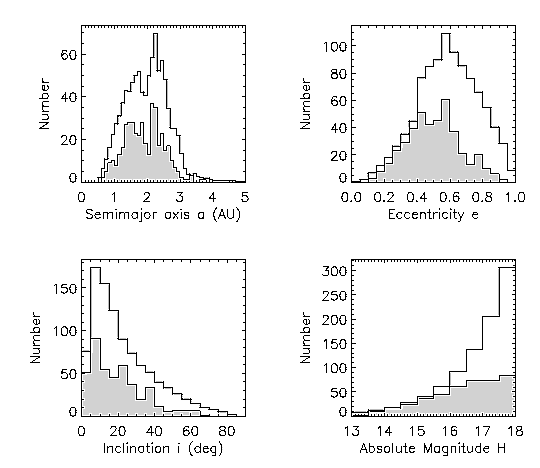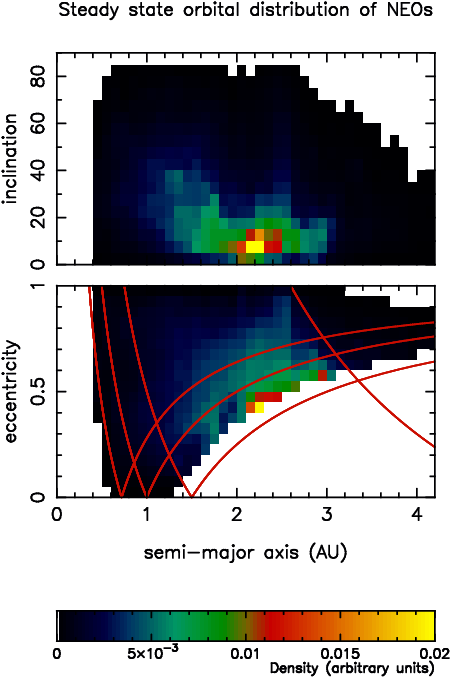
Most of the undiscovered NEOs have H larger than 16, e larger than 0.4, a in the range 1-3AU and i between 5-40 degrees.
We present in this page our model of the debiased distribution of Near Earth Objects with respect to semi major axis, eccentricity, inclination and absolute magnitude.
The total NEO population contains
960+/- 120 objects with absolute magnitude H<18 (roughly 1 km
in diameter) and 24,500+/- 3000 objects with absolute magnitude H<22
(roughly 150 m in diameter), with semi major axis a<7.4
AU. Hence current observational completeness
of the H<18 population is ~50%. The NEO absolute
magnitude distribution implies a power law cumulative size distribution
with exponent -1.75 +/- 0.1. This distribution is in perfect agreement
with that obtained by Rabinowitz et al. (Nature, 403, 165, 2000),
who directly debiased the magnitude distribution observed by the NEAT
survey. Once scaling
laws are taken into account, it is also in agreement with the -2 mean
exponent of the cumulative crater
size distributions observed on all terrestrial planets and the
Moon.
 |
The debiased orbital-magnitude
distribution of the NEOs with H<18 . The predicted NEO distribution
(solid line) is normalized to 960 objects. It is compared with the
426 known NEOs for all surveys (shaded histogram).
Most of the undiscovered NEOs have H larger than 16, e larger than 0.4, a in the range 1-3AU and i between 5-40 degrees. |
Overall, 32+/- 1% of the NEOs are Amors,
62+/-1% are Apollos, and 6+/-1% are
Atens.
Moreover 49+/-4% of the NEOs have a<2 AU; 55+/-2%
have i<20 degrees and 52+/-2% have e<0.6 .
The ratio between the IEO and the NEO
populations is about 2%.
 |
The debiased orbital distribution of the Near Earth Objects. The colors indicate the relative density of objects in the network of cells in the a,e and a,i planes. The red curves delimit the Venus-, Earth-, Mars- and Jupiter-crossing regions, respectively. |
With this orbital distribution, and assuming random orientations of the orbits, about 2% of the NEOs turn out to have a Minimal Orbital Intersection Distance (MOID) with the Earth smaller than 0.05 AU. NEOs with MOID<0.05 AU are classified as Potentially Hazardous Objects (PHOs), and the accurate orbital determination of these bodies is considered a top priority.
We estimate that the Earth collides with a H<18
NEO once every 0.5 million years, on average.